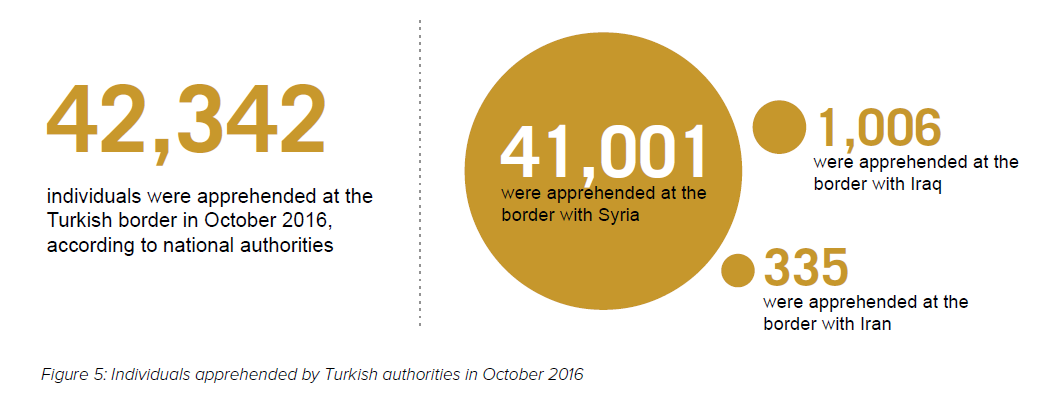Up to 16,000 people have been displaced from Aleppo since government forces began a “renewed push” into the eastern part of the city on 15 November. Many have fled north towards the border with Turkey, and more can be expected as the fighting intensifies. They join an estimated 100,000 people already stranded on the Syrian side of the border. While international attention continues to focus on refugees and migrants entering, or attempting to enter, EU countries from Turkey, less consideration is given to the thousands of people trying to enter Turkey itself. Despite limited attention towards arrivals at the Turkish border, the number of people apprehended entering Turkey irregularly in October far exceeded the number who left in the same way.
Almost 100,000 people were reportedly apprehended along the Turkish borders with Syria and Iraq in September and October alone. By comparison, the Turkish Coast Guard reported only 2,437 ‘irregular migrants’ leaving Turkey and attempting the crossing to Europe in October, a figure 94.2% smaller than the number apprehended entering the country by land in the same month.
Disproportionate attention to refugees crossing to Greece and limited information about the number of people who manage to cross Turkey’s land borders undetected risks ignoring a large group of potentially vulnerable refugees and other migrants, who in many ways are invisible to the media and public eye. While Turkish officials claim that the country maintains an ‘open door’ policy for emergency situations, the land border has been effectively closed since March 2015, with strict visa requirements for Syrians entering Turkey by air or sea making it increasingly difficult, if not impossible, to cross legally. While critical medical cases are being admitted through the two official border crossings that remain open with Syria, at most only 200 people are allowed entry per day – a fraction of the number apprehended by border guards when trying to cross irregularly.
Reports of violence, abuse, and deaths at the Turkey-Syria border only heighten concerns for the protection of people attempting to enter Turkey whilst fleeing conflict in Syria and Iraq, although the Turkish government maintains that claims of violence “do not reflect the reality at the border.”
Refugees and other migrants must also contend with the wall being constructed along Turkey’s 900km border with Syria – 200km of which has already been constructed. This project has a completion date of February 2017 and aims to fence off the entire border.

Syrians face physical and legal barriers to escape in other directions too. With an estimated 85,000 Syrians stuck at Syria’s border with Jordan, and strict visa requirements blocking the passage of refugees into Lebanon, exiting Syria has become an almost impossible task
Nonetheless, it must be assumed that many do manage to flee into Turkey and onwards, with 2,970 refugees and other migrants arriving in Greece by sea in October alone. The 100,000 people apprehended by Turkish border guards throughout September and October make up just part of the total flow of refugees and other migrants entering Turkey irregularly.
Increased border restrictions often lead to irregular movements of people across borders, accompanied by increased risks for people on the move. IOM’s data shows that the number of people reporting experiences of trafficking or other exploitative practices along the Eastern Mediterranean route has increased from 6.5% in May, to 14% in September, a change likely tied to the closure of the Western Balkans route and the implementation of the EU-Turkey Agreement. Reported experiences include people being held against their will by non-governmental authorities (often smugglers), forced labour, and lack of payment for work throughout the journey to Europe.
In the same way, hidden, or ignored, people moving irregularly into Turkey likely face significant vulnerability and protection concerns, which need further and immediate attention.
For more information on this and other mixed migration issues in the Middle East, please access the Mixed Migration Platform’s October Mixed Migration Summary (accessible here).
Note: This article originally appeared on the RMMS Horn of Africa website.